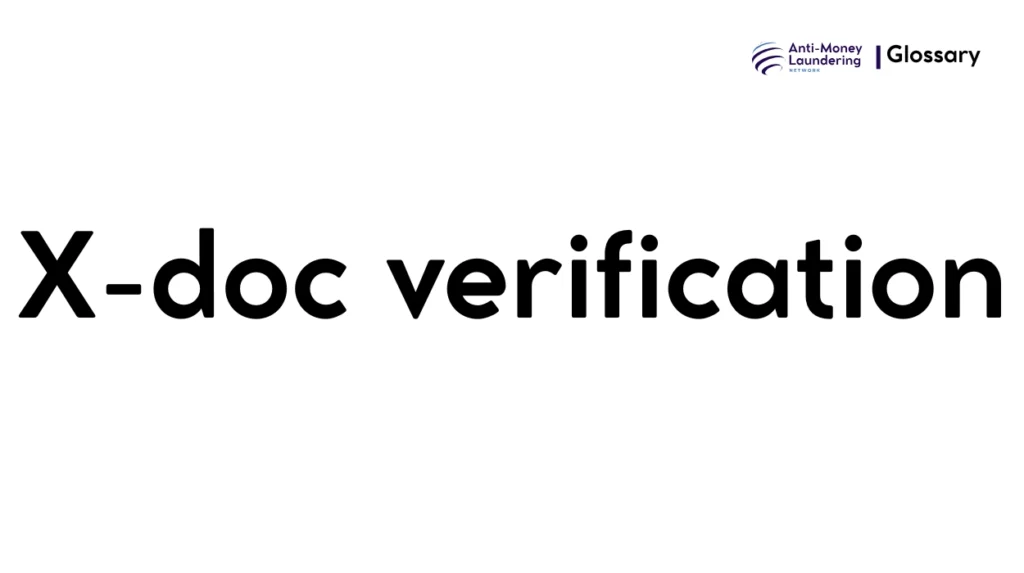Definition
X-doc verification in Anti-Money Laundering (AML) refers to a specialized process of authenticating and validating multiple documents that a customer or entity submits during compliance checks. The term “X-doc” implies cross-verification of documents to ensure consistency, authenticity, and to detect forgery or manipulation. It complements standard AML identity verification by requiring several independent documents to confirm an individual or entity’s identity and background, reducing risk of illicit financial activity.
Purpose and Regulatory Basis
The primary purpose of X-doc verification is to prevent money laundering, terrorist financing, and other illegal financial activities by ensuring customer identities and documents are valid and reliable. It strengthens Know Your Customer (KYC) and Customer Due Diligence (CDD) processes to meet stringent regulatory requirements.
Global and national AML regulations underpinning X-doc verification include:
- Financial Action Task Force (FATF) Recommendations: Mandate robust customer identification and verification.
- USA PATRIOT Act: Requires financial institutions to verify customer identities through reliable documents.
- European Union AML Directives (AMLD): Emphasize enhanced due diligence supported by comprehensive document verification.
By enforcing cross-document verification, institutions align with these regulations to reduce fraud, reputational risk, and regulatory penalties.
When and How it Applies
Institutions apply X-doc verification when onboarding new customers, especially for high-risk profiles or transactions. Common triggers include:
- Opening new accounts, particularly in banking or financial services.
- Large or unusual transactions needing enhanced due diligence.
- Customer profiles flagged for Politically Exposed Persons (PEP) or sanction lists.
In practice, a client may be asked to submit multiple documents such as a passport, utility bill, and bank statements. X-doc verification involves checking:
- Consistency across client name, address, and other personal data.
- Authenticity of each document via security features and external database matches.
- Correlation of document timelines and validity periods.
Types or Variants
There are variations of X-doc verification depending on institutional risk appetite and regulatory context:
- Basic X-doc Verification: Cross-checking basic ID documents such as passport and driver’s license.
- Enhanced X-doc Verification: Includes verification of financial statements, business registrations, or utility bills.
- Biometric X-doc Verification: Combines document checks with biometric verification like facial recognition or fingerprint scans.
These variants allow institutions to scale their processes according to client risk levels.
Procedures and Implementation
Institutions implement X-doc verification through the following steps:
- Document Collection: Collect multiple identity and proof of address documents from the client.
- Automated Document Analysis: Use technologies like Optical Character Recognition (OCR), Artificial Intelligence (AI), and machine learning to detect forgeries and verify document security features.
- Cross-Verification: Match data points (name, date of birth, address) across all documents for consistency.
- External Database Checks: Validate documents against national ID registries, sanction lists, and credit bureaus.
- Biometric Verification (if applicable): Confirm that the person submitting documents matches biometric data.
- Flagging and Escalation: Any anomalies or inconsistencies trigger alerts for manual review.
- Record-Keeping: Maintain audit trails of all verification activities for regulatory compliance.
These procedures demand robust IT infrastructure, staff training, and regular process reviews.
Impact on Customers/Clients
From a customer perspective, X-doc verification:
- Increases trust by demonstrating commitment to security and regulatory compliance.
- May extend onboarding time, as multiple documents are required.
- Results in restrictions or delays if document inconsistencies or suspicions arise.
Customers have the right to be informed about data usage and to have their documents handled securely and confidentially under data protection laws.
Duration, Review, and Resolution
X-doc verification is not a one-time event:
- Initial verification occurs at onboarding.
- Periodic Reviews: Institutions must re-verify documents periodically, especially for long-term clients or those entering higher risk environments.
- Ongoing Monitoring: Transaction monitoring may prompt additional document verifications.
- Resolution involves resolving discrepancies through customer outreach or enhanced due diligence.
Reporting and Compliance Duties
Financial institutions must:
- Document all X-doc verification outcomes.
- Report suspicious findings to designated AML officers.
- File Suspicious Activity Reports (SARs) as required.
- Ensure audit readiness by maintaining comprehensive records for regulators.
- Face penalties, including fines and license revocation, for non-compliance.
Related AML Terms
X-doc verification is closely related to:
- Know Your Customer (KYC): Overall process of identity verification.
- Customer Due Diligence (CDD) and Enhanced Due Diligence (EDD): Risk-based approaches relying on document verification.
- Politically Exposed Persons (PEP) Check: Cross-document verification helps identify PEPs.
- Sanctions Screening: Document data is used to screen against watch lists.
Challenges and Best Practices
Common challenges include:
- High false positive rates causing delays.
- Sophisticated document forgeries.
- Privacy concerns over data handling.
Best practices:
- Leverage AI and machine learning to improve accuracy.
- Continuous staff training on emerging fraud trends.
- Implement strong data protection policies.
- Engage in collaborative information sharing within the industry.
Recent Developments
Technological advances enhancing X-doc verification include:
- Artificial Intelligence for pattern recognition and fraud detection.
- Biometric Integration providing multi-factor authentication.
- Blockchain technology for tamper-proof document records.
- Cloud-based platforms enabling scalable and secure verification processes.
Regulatory frameworks evolve simultaneously, demanding ongoing updates to verification protocols.
X-doc verification is a critical, multi-document authentication process in AML compliance. It fortifies identity verification, mitigates risks of money laundering and terrorist financing, and meets global regulatory mandates. By implementing thorough procedures and embracing technological advancements, financial institutions enhance security, maintain trust, and uphold their regulatory obligations in today’s complex financial environment.

